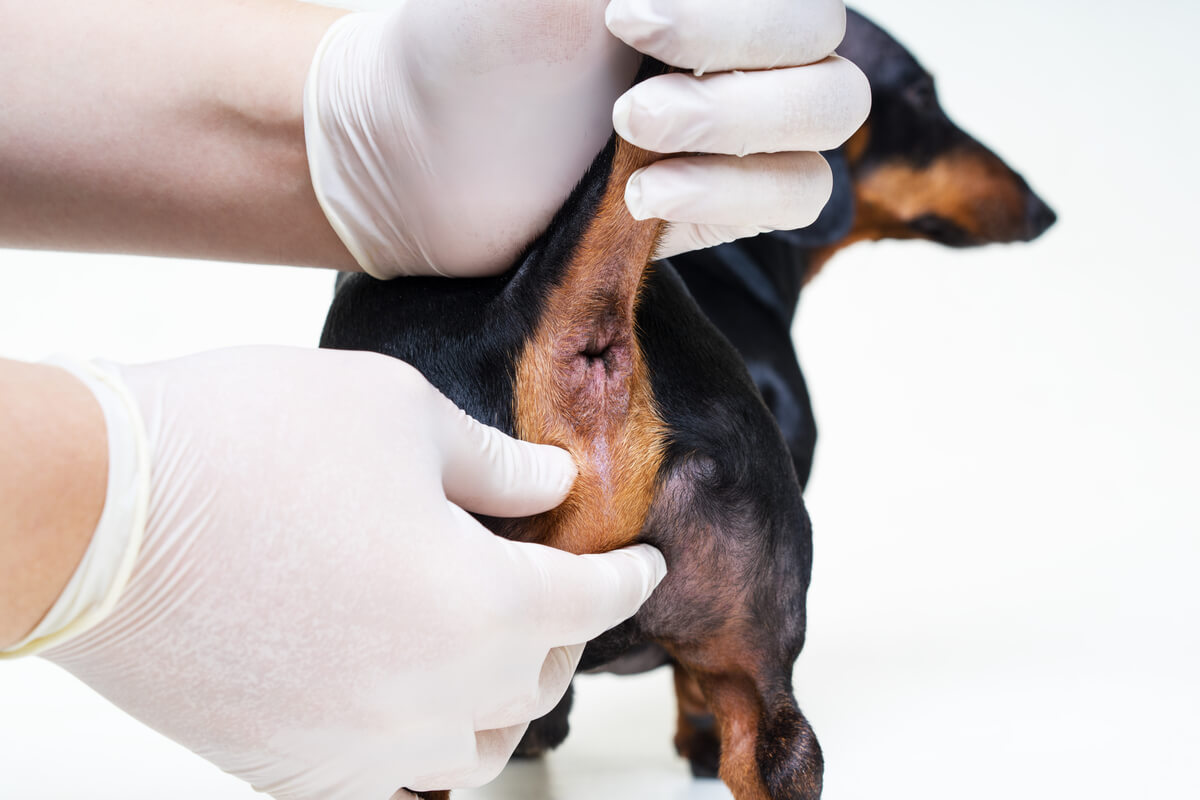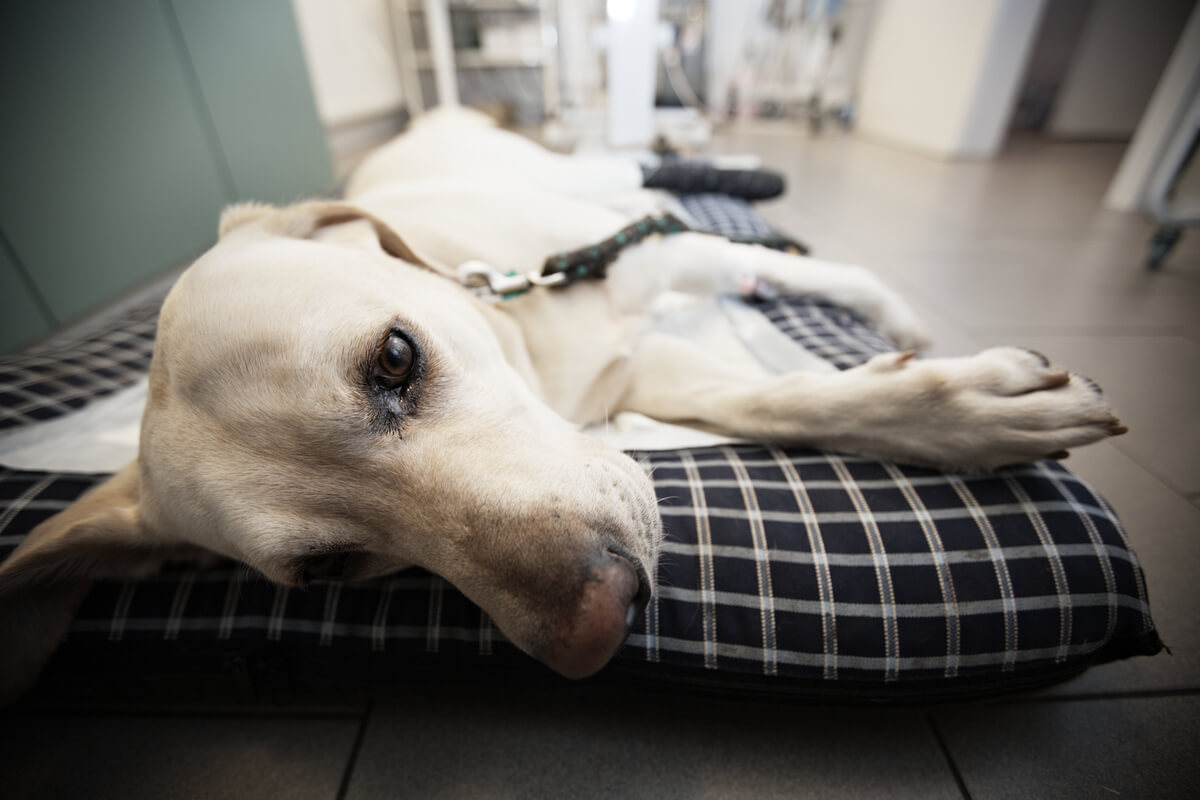Perianal Tumors in Dogs: Symptoms and Treatment


Written and verified by the biologist Samuel Sanchez
Cancer is a disease that occurs in virtually all vertebrates, not just humans. The neoplastic tumor appears due to a mutation in a cell line, which begins to grow excessively and doesn’t follow normal apoptosis and development parameters. This may be the initial event that triggers perianal tumors in dogs, but not all masses are cancerous.
Tumors in the perianal glands are very common in dogs, but sources that we will see later estimate that 81 to 96% of them are benign non-cancerous masses. If you want to differentiate between the two conditions and know everything about canine perianal tumors, keep reading.
What are perianal tumors?
The anal sacs include groupings of glands located in the anus of both dogs and cats. The walls of these structures are lined with a large number of sebaceous glands, which produce a fluid with a characteristic odor. This fluid is stored in the anal sacs, which in turn release it through a conduit directly to the anus.
This fluid is an excellent method of chemical communication in dogs, since the secretions of the perianal glands are used to mark territories and alert other canids to the presence of another dog in any given environment. The anal sacs contract with bowel movements, thus releasing fluids along with stools.
The problem comes when a group of secretory cells in the wall of the sacs begins to grow more than normal. If the cell line develops to some extent in a self-limited way, it’s a benign tumor, but if it has metastatic potential, it’s considered to be cancerous.
The anal glands give the dog’s feces its own and non-transferable smell.

Types of perianal tumors in dogs
As indicated by professional veterinary sources, a pet can suffer from different types of perianal tumors. We’ll tell you the most important ones in the following lines.
Perianal adenoma
Perianal adenomas are benign tumors that correspond to more than 80% of neoplastic conditions in this region. According to the article Hormone-dependent neoplasms of the canine perianal gland, published in the medical journal PubMed, these masses are dependent on hormonal activity (androgens). For this reason, males are up to 5.6 times more likely than females to suffer from these adenomas.
These tumors aren’t usually painful and don’t grow more than 3 centimeters (2.2 inches), although they can be ulcerated and cause some medical problems if they aren’t treated. Despite not being carcinogenic, they must be removed.
Perianal adenocarcinoma
Perianal adenocarcinomas account for less than 10% of tumors in these areas and they’re carcinogenic. Unlike adenomas, these can grow up to 10 centimeters (4 inches) in length and spread to other areas of the animal. Tumor masses can spread to the lymph nodes, the abdominal region, and the lungs.
Epithelioma
An epithelioma is an abnormal growth of the epithelium, the layer of tissue that lines the surface of the organs and other structures of the animal’s body. Epitheliomas are considered almost malignant (borderline malignant) and are very rare, so we won’t focus our attention on them.
Other tumors, such as lymphomas, melanomas, and mast cell tumors can appear in this area. However, they aren’t exclusive to the anal region.
Symptoms of perianal tumors in dogs
As you can imagine, the symptoms vary greatly depending on the condition of the animal, as a benign tumor (adenoma) is totally different from a malignant one (adenocarcinoma). Let’s have a look at the general symptoms in both cases:
- Pinkish nodule (s) around the anus: These correspond to one or more tumor masses, and they’re small and not covered with hair. Benign tumors don’t usually grow more than 3 centimeters (2.2 inches), while malignant ones grow much bigger. Adenomas are superficial and rarely affect deep tissues.
- Signs of infection: The abnormal mass may become infected or ulcerate. In these cases, the dog may have inflammation in the anal area, as well as vesicles filled with pus and reddish papules.
- Difficulty defecating: This clinical sign is only seen in adenocarcinomas, with few exceptions. Because cancer infects deeper tissues, the perianal tumor can cause a mechanical obstruction in the rectum area.
- Systemic symptoms: If the cancer spreads to other areas of the body, the symptoms will depend on the affected place. From apathy to respiratory failure, a metastasis can manifest itself in many ways.
In addition, 30 to 50% of dogs with adenocarcinomas have paraneoplastic hypercalcemia, which results in excess calcium (Ca) in the blood. This syndrome manifests itself in the form of tiredness, lethargy, mental confusion, anorexia, vomiting, constipation, and other systemic symptoms.
How is perianal tumor diagnosed in dogs?
Faced with any of the aforementioned symptoms, it is necessary to take the pet promptly to the vet. The professional will suspect the presence of a perianal tumor by looking at the mass directly or by noticing lumps — either in the glands or in the adjacent lymph nodes — during rectal palpation.
In any case, to separate an adenoma from an adenocarcinoma, laboratory analysis of a sample of the tumor tissue is necessary. Sometimes the diagnosis is confirmed once the tumor mass has been completely removed.
Treatment of perianal tumors
Treatment of any tumor – whether malignant or not – involves surgical removal of the neoplastic mass. If the dog has an adenocarcinoma, it may be necessary to also remove compromised adjacent tissues, as remnants of the cancer may remain and cause relapses. According to the EMBRACE Pet Insurance portal, less than 10% of dogs develop adenomas again after being treated.
However, sometimes surgical removal cannot be done immediately. If the mass is close to the anal sphincter or the edges are diffuse, it’s recommended to begin treatment with castration – in the case of males. If the gonads are removed, the action of androgens is reduced and the mass should decrease in size.
On the other hand, if the tumor is of the adenoma type and very small, then cryotherapy or laser ablation can be used. Radiation therapy and chemotherapy are recommended in the most advanced adenocarcinomas, although the animal’s previous health status and age must be taken into account before embarking on such demanding processes – at both a health and monetary level.

Final notes
The prognosis of the perianal tumor in dogs will depend on the age of the animal, the type of neoplasm, and the state of advance of the mass. Adenomas don’t usually cause any problems after their extraction, as they disappear completely in more than 90% of cases, as long as the procedure is accompanied by castration.
On the other hand, the prognosis of adenocarcinomas is very delicate. These tumors grow fast and can easily spread to adjacent structures, so surgical removal is not always the final solution. Depending on whether there are metastases or not, the chances of survival of the canine patient will vary.
All cited sources were thoroughly reviewed by our team to ensure their quality, reliability, currency, and validity. The bibliography of this article was considered reliable and of academic or scientific accuracy.
- Hepatoid gland tumor, VCA Hospitals. Recogido a 14 de junio en https://vcahospitals.com/know-your-pet/hepatoid-gland-tumors
- Perianal Adenoma in dogs, EMBRACE Pet Insurance. Recogido a 14 de junio en https://www.embracepetinsurance.com/health/perianal-adenoma
- Choi, E. W. (2019). Deep dermal and subcutaneous canine hemangiosarcoma in the perianal area: diagnosis of perianal mass in a dog. BMC veterinary research, 15(1), 1-5.
- McGavin, M. D., & Fishburn, F. (1975). Perianal adenoma of apocrine origin in a dog. Journal of the American Veterinary Medical Association, 166(4), 388-389.
- Dow, S. W., Olson, P. N., Rosychuk, R. A., & Withrow, S. J. (1988). Perianal adenomas and hypertestosteronemia in a spayed bitch with pituitary-dependent hyperadrenocorticism. Journal of the American Veterinary Medical Association, 192(10), 1439-1441.
This text is provided for informational purposes only and does not replace consultation with a professional. If in doubt, consult your specialist.